Temporal Refinement of Major Primary Air Pollutant Emissions Based on Electric Power Big Data: A Case of the Cement Industry in Tangshan City
Abstract
:1. Introduction
2. Data and Methods
2.1. Collection and Preprocessing of Electricity Consumption Data
2.2. Comparison of Electric Variations with Relevant Activity Data
2.3. Estimation of Hourly Resolved Facility-Level Emissions
2.4. Evaluation of Inventory Optimization
3. Results and Discussion
3.1. Daily and Hourly Emission Patterns from the Cement Industry
3.2. Uncertainty Analysis
3.3. Evaluation of Simulation Optimization Results
4. Conclusions
Author Contributions
Funding
Institutional Review Board Statement
Informed Consent Statement
Data Availability Statement
Acknowledgments
Conflicts of Interest
Appendix A
| Reference | Source Categories | CEMS Data Coverage |
|---|---|---|
| Tang et al. [8] | Chinese power plants | 95.91% of total thermal power capacity for 2016 |
| Karplus et al. [9] | 256 power plants in four Chinese provinces: Guangdong, Hubei, Shandong, and Shanghai | |
| Wu et al. [6] | 96.4% of total thermal power capacity from 2017 to 2020 | |
| Bo et al. [7] | China’s iron and steel industry | 69–91% of national iron and steel production |
| Liu et al. [10] | 81% of these member companies were included in the CEMS | |
| Tang et al. [11] | Ten Chinese industrial sectors | 7708 generating plants across different industrial sectors from 2015 to 2018 |
| Number | Station Name | Coordinate Information |
|---|---|---|
| 1 | Fengrun District Government | 118.16° E, 39.83° N |
| 2 | Leida Station | 118.13° E, 39.64° N |
| 3 | Wuzi Station | 118.17° E, 39.63° N |
| 4 | Xiaoshan Station | 118.19° E, 39.62° N |
| 5 | Zhengtai Street Heat Station | 118.09° E, 39.58° N |
| 6 | Jinshan School | 118.44° E, 39.74° N |
| 7 | Government service center | 118.24° E, 39.67° N |
| 8 | Squadron of Xiaofanggangyao Road | 118.21° E, 39.66° N |
| 9 | Lunandianda Station | 118.14° E, 39.62° N |
| 10 | Twelve middle schools | 118.17° E, 39.65° N |
| 11 | The supply and marketing cooperative | 118.17° E, 39.63° N |
| 12 | Ceramic company | 118.22° E, 39.67° N |
| Variables | Data Sources |
|---|---|
| EPBD | State Grid Jibei Electric Power Co., Ltd., in China |
| Location of 83 cement industries | Bai et al., 2023 [28] |
| LC,i and LCG,i | Calculated by the ratio of actual hourly electricity consumption to maximum hourly electricity consumption |
| CC,i and CCG,i | Tangshan Municipal Ecology and Environment Bureau in China |
| EFC,m and EFCG,m | Technical Manual for Compilation of Air Pollution Emission Inventory [35] |
| and | |
| Hourly ground-level observed PM2.5, SO2, and NO2 concentration data | China National Environmental Monitoring Center |
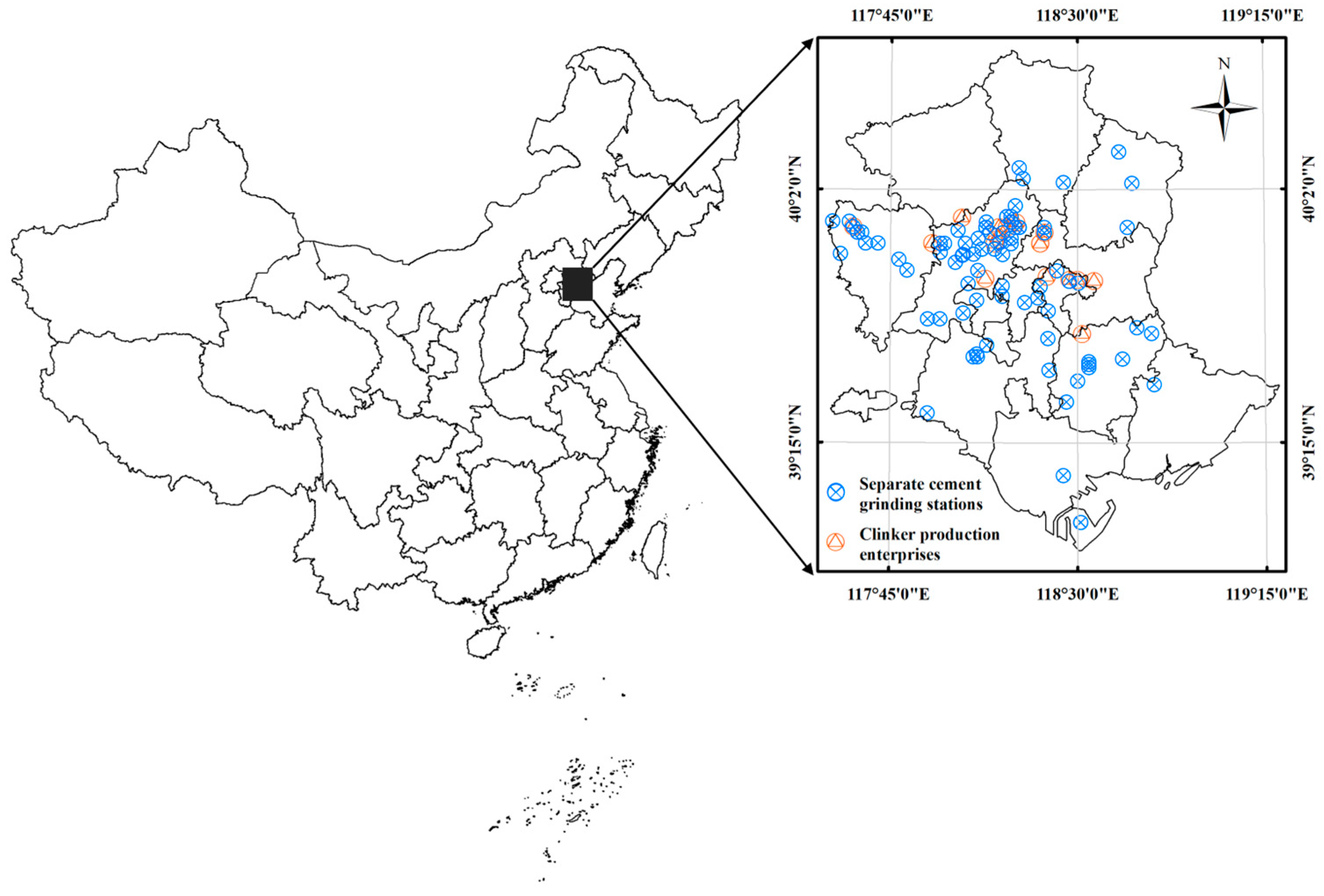
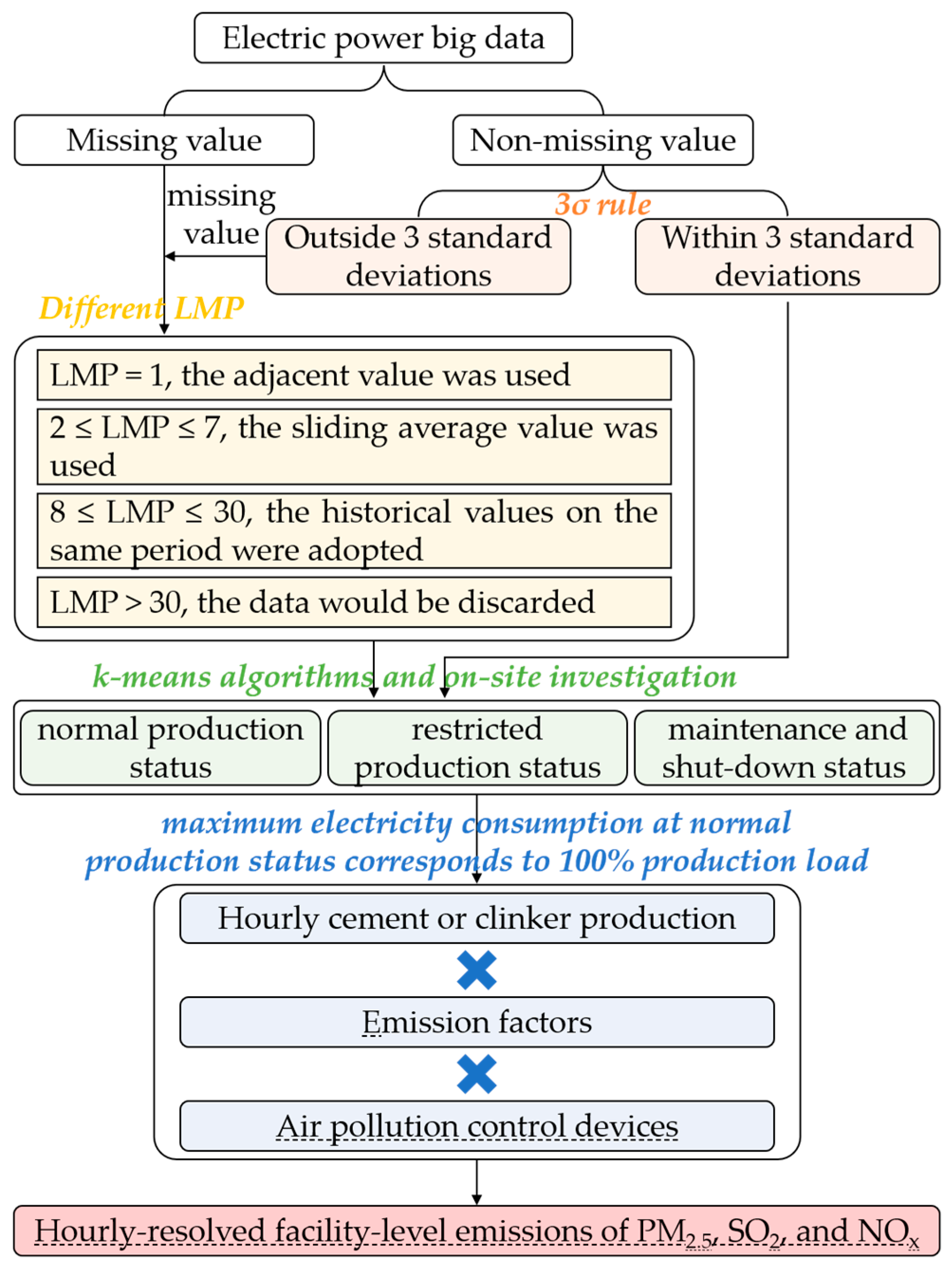
References
- Lei, Y.; Yin, Z.C.; Lu, X.; Zhang, Q.; Gong, J.C.; Cai, B.F.; Cai, C.; Chai, Q.M.; Chen, H.P.; Chen, R.J.; et al. The 2022 report of synergetic roadmap on carbon neutrality and clean air for China: Accelerating transition in key sectors. Environ. Sci. Ecotechnol. 2024, 19, 100335. [Google Scholar] [CrossRef] [PubMed]
- Li, C.; van Donkelaar, A.; Hammer, M.S.; McDuffie, E.E.; Burnett, R.T.; Spadaro, J.V.; Chatterjee, D.; Cohen, A.J.; Apte, J.S.; Southerland, V.A.; et al. Reversal of trends in global fine particulate matter air pollution. Nat. Commun. 2023, 14, 5349. [Google Scholar] [CrossRef]
- WHO. Billions of People Still Breathe Unhealthy Air: New WHO Data. 2022. Available online: https://www.who.int/news/item/04-04-2022-billions-of-people-still-breathe-unhealthy-air-new-who-data (accessed on 7 July 2024).
- Li, M.; Liu, H.; Geng, G.N.; Hong, C.P.; Liu, F.; Song, Y.; Tong, D.; Zheng, B.; Cui, H.Y.; Man, H.Y.; et al. Anthropogenic emission inventories in China: A review. Natl. Sci. Rev. 2017, 4, 834–866. [Google Scholar] [CrossRef]
- Streets, D.G.; Devane, M.K.; Lu, Z.; Bond, T.C.; Sunderland, E.M.; Jacob, D.J. All-time releases of mercury to the atmosphere from human activities. Environ. Sci. Technol. 2011, 45, 10485–10491. [Google Scholar] [CrossRef] [PubMed]
- Wu, N.N.; Geng, G.N.; Qin, X.Y.; Tong, D.; Zheng, Y.X.; Lei, Y.; Zhang, Q. Daily emission patterns of coal-fired power plants in China based on multisource data fusion. ACS Environ. Au 2022, 2, 363–372. [Google Scholar] [CrossRef]
- Bo, X.; Jia, M.; Xue, X.D.; Tang, L.; Mi, Z.F.; Wang, S.Y.; Cui, W.G.; Chang, X.Y.; Ruan, J.H.; Dong, G.X.; et al. Effect of strengthened standards on Chinese ironmaking and steelmaking emissions. Nat. Sustain. 2021, 4, 811–820. [Google Scholar] [CrossRef]
- Tang, L.; Qu, J.B.; Mi, Z.F.; Bo, X.; Chang, X.Y.; Anadon, L.D.; Wang, S.Y.; Xue, X.D.; Li, S.B.; Wang, X.; et al. Substantial emission reductions from Chinese power plants after the introduction of ultra-low emissions standards. Nat. Energy 2019, 4, 929–938. [Google Scholar] [CrossRef]
- Karplus, V.J.; Shuang, Z.; Douglas, A. Quantifying coal power plant responses to tighter SO2 emissions standards in China. Proc. Natl. Acad. Sci. USA 2018, 115, 201800605. [Google Scholar] [CrossRef]
- Liu, J.; Wang, S.; Yi, H.H.; Tang, X.L.; Li, Z.L.; Yu, Q.J.; Zhao, S.Z.; Gao, F.Y.; Zhou, Y.S.; Wang, Y.X. Air pollutant emission and reduction potentials from the sintering process of the iron and steel industry in China in 2017. Environ. Pollut. 2022, 307, 119512. [Google Scholar] [CrossRef]
- Tang, L.; Jia, M.; Yang, J.N.; Li, L.; Bo, X.; Mi, Z.F. Chinese industrial air pollution emissions based on the continuous emission monitoring systems network. Sci. Data 2023, 10, 153. [Google Scholar] [CrossRef]
- Huang, Y.H.; Zhou, X.X. Knowledge model for electric power big data based on ontology and semantic web. CSEE J. Power Energy 2015, 1, 19–27. [Google Scholar] [CrossRef]
- Zhou, K.L.; Fu, C.; Yang, S.L. Big data driven smart energy management: From big data to big insights. Renew. Sust. Energ. Rev. 2016, 56, 215–225. [Google Scholar] [CrossRef]
- Zhou, W.Q.; Yang, J.Q.; Ning, L.; Wu, H.C.; Bo, Y.; Zhang, Q.; Tian, H.Z. Construction and application of air pollutant emission accounting model for iron and steel enterprises based on power big data. Res. Environ. Sci. 2014, 37, 299–307. [Google Scholar]
- Geng, J.Q.; Meng, W.G.; Yang, Q.R. Electricity substitution potential prediction based on Tent-CSO-CG-SSA-Improved SVM—A case study of China. Sustainability 2022, 14, 853. [Google Scholar] [CrossRef]
- Niu, D.X.; Gao, T.; Ji, Z.S.; Liu, Y.J.; Wu, G.Q. Analysis of the efficiency of provincial electricity substitution in China based on a three-stage DEA model. Energies 2021, 14, 6650. [Google Scholar] [CrossRef]
- Song, H.Y.; Hou, G.S.; Xu, S. CO2 emissions in China under electricity substitution: Influencing factors and decoupling effects. Urban Clim. 2023, 47, 101365. [Google Scholar] [CrossRef]
- Liddle, B.; Sadorsky, P. How much does increasing non-fossil fuels in electricity generation reduce carbon dioxide emissions? Appl. Energ. 2017, 197, 212–221. [Google Scholar] [CrossRef]
- Cai, D.F.; Tian, H.X.; Wang, Y.; Wang, H.G.; Zheng, H.F.; Cao, K.; Zhou, C. Electric power big data and its applications. In Proceedings of the 2016 International Conference on Energy, Power and Electrical Engineering, Shenzhen, China, 30–31 October 2016; Atlantis Press: Amsterdam, The Netherlands, 2016; pp. 181–184. [Google Scholar]
- Zhan, J.; Huang, J.X.; Niu, L.; Peng, X.S.; Deng, D.Y.; Deng, S.J. Study of the key technologies of electric power big data and its application prospects in smart grid. In Proceedings of the Power & Energy Engineering Conference, Hong Kong, China, 7–10 December 2014. [Google Scholar]
- Ji, G.Q.; Li, F.R.; Ding, J.M.; Shan, T.H.; Wang, Z.M.; Qin, L.H.; Wu, X.M. Correlation analysis between electricity consumption and air quality in Tangshan area based on data mining. Electron. World 2017, 1, 22–24. [Google Scholar] [CrossRef]
- Wu, L.B.; Zhou, Y.; Chen, H.B.; Yang, Z.H. Emission characteristics of industrial air pollution by using smart-grid big data. Chin. J. Environ. Manag. 2016, 8, 37–42. [Google Scholar]
- Zhou, W.Q.; Li, P.; Wu, H.C.; He, X.J.; Sun, S.D.; Bo, Y.; He, K.B. Research on optimizing air pollutant emission inventory based on electricity consumption data. China Environ. Sci. 2023, 43, 3350–3359. [Google Scholar]
- Liu, H.; Huang, F.P.; Li, H.; Liu, W.W.; Wang, T.X. A big data framework for electric power data quality assessment. In Proceedings of the 2017 14th Web Information Systems and Applications Conference (WISA), Liuzhou, China, 11–12 November 2017; pp. 289–292. [Google Scholar]
- Park, W.; Nam, K.; Choi, S. Determination of the minimum detectability of surface plasmon resonance devices by using the 3σ rule. J. Korean Phys. Soc. 2020, 76, 1010–1013. [Google Scholar] [CrossRef]
- Gao, P.Z.; Wang, M.; Ghiocel, S.G.; Chow, J.H. Missing data recovery by exploiting low-dimensionality in power system synchrophasor measurements. IEEE T. Power Syst. 2016, 31, 1006–1013. [Google Scholar] [CrossRef]
- Zhang, Y.T.; Liu, S.K.; Zhang, L.; Liu, C.; Liu, S.C.; Cui, Z.Q. Assessment method for power system transient stability with missing data. Proc. CSU-EPSA 2023, 35, 59–68. [Google Scholar]
- Bai, X.X.; Liu, W.; Wu, B.B.; Liu, S.H.; Liu, X.Y.; Hao, Y.; Liang, W.Z.; Lin, S.M.; Luo, L.N.; Zhao, S.; et al. Emission characteristics and inventory of volatile organic compounds from the Chinese cement industry based on field measurements. Environ. Pollut. 2023, 316, 120600. [Google Scholar] [CrossRef] [PubMed]
- Bai, X.X.; Tian, H.Z.; Liu, X.Y.; Wu, B.B.; Liu, S.H.; Hao, Y.; Luo, L.N.; Liu, W.; Zhao, S.; Lin, S.M.; et al. Spatial-temporal variation characteristics of air pollution and apportionment of contributions by different sources in Shanxi province of China. Atmos. Environ. 2021, 244, 117926. [Google Scholar] [CrossRef]
- Liu, X.Y.; Li, N.; Mu, H.L.; Li, M.; Liu, X.X. Multiobjective optimization and parameters study of hybrid offshore wind and pumped hydrostorage power system: Modeling and case study. J. Renew. Sustain. Energy 2021, 13, 049825. [Google Scholar] [CrossRef]
- Gurney, K.R.; Song, Y.; Liang, J.M.; Roest, G. Toward accurate, policy-relevant fossil fuel CO2 emission landscapes. Environ. Sci. Technol. 2020, 54, 9896–9907. [Google Scholar] [CrossRef]
- US EPA. Guidance on the Use of Models and Other Analyses for Demonstrating Attainment of Air Quality Goals for Ozone, PM2.5, and Regional Haze; Office of Air and Radiation/Office of Air Quality Planning and Standards: Research Triangle Park, NC, USA, 2007.
- Chemel, C.; Sokhi, R.S.; Yu, Y.; Hayman, G.D.; Vincent, K.J.; Dore, A.J.; Tang, Y.S.; Prain, H.D.; Figher, B.E.A. Evaluation of a CMAQ simulation at high resolution over the UK for the calendar year 2003. Atmos. Environ. 2010, 44, 2927–2939. [Google Scholar] [CrossRef]
- Wang, L.T.; Wei, Z.; Yang, J.; Zhang, Y.; Zhang, F.F.; Su, J.; Meng, C.C.; Zhang, Q. The 2013 severe haze over southern Hebei, China: Model evaluation, source apportionment, and policy implications. Atmos. Chem. Phys. 2014, 14, 3151–3173. [Google Scholar] [CrossRef]
- He, K.B. Technical Manual for Compilation of Air Pollution Emission Inventory; Tsinghua University: Beijing, China, 2018. [Google Scholar]
Disclaimer/Publisher’s Note: The statements, opinions, and data contained in all publications are solely those of the individual author(s) and contributor(s) and not of MDPI and/or the editor(s). MDPI and/or the editor(s) disclaim responsibility for any injury to people or property resulting from any ideas, methods, instructions or products referred to in the content. |
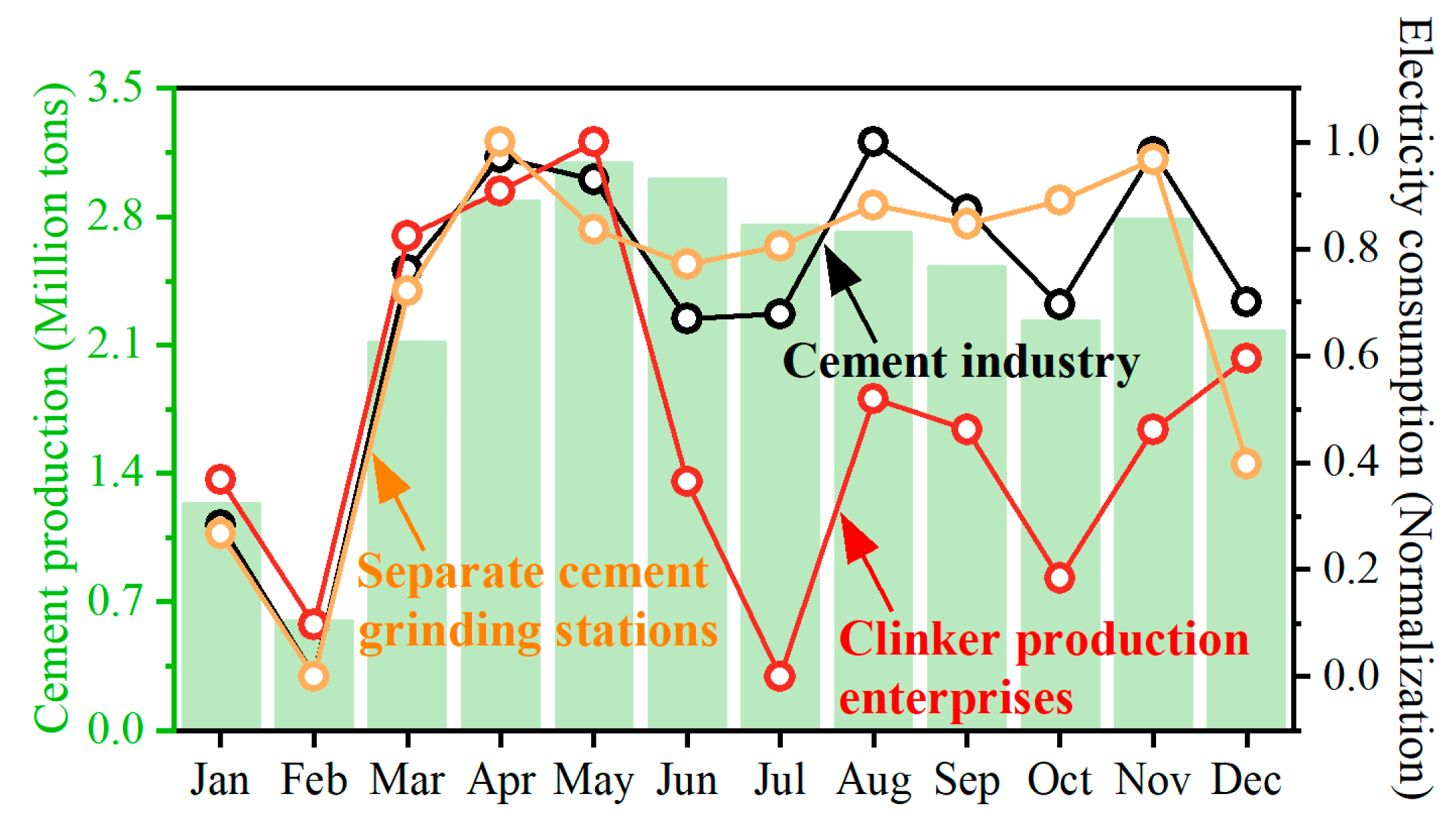
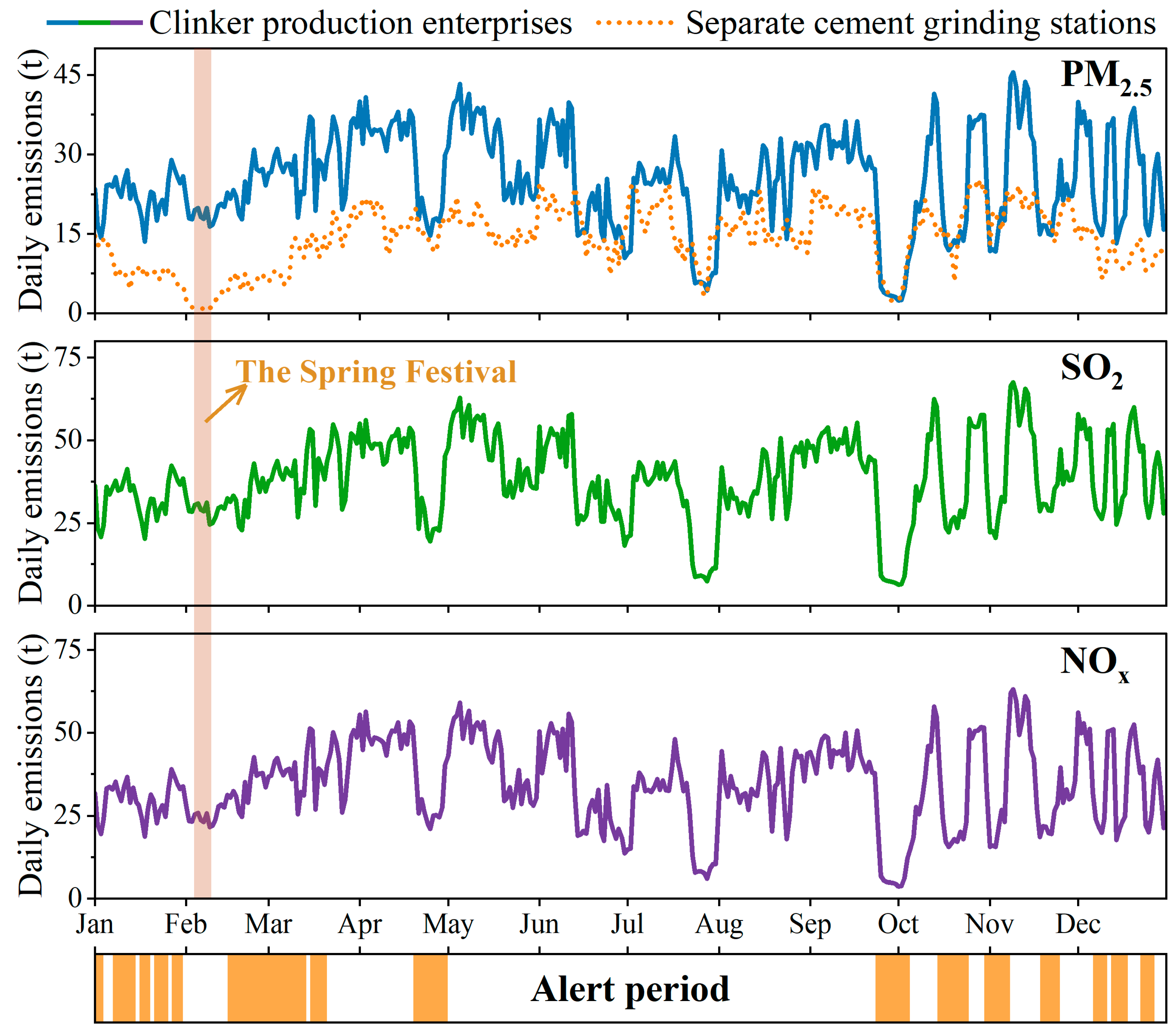

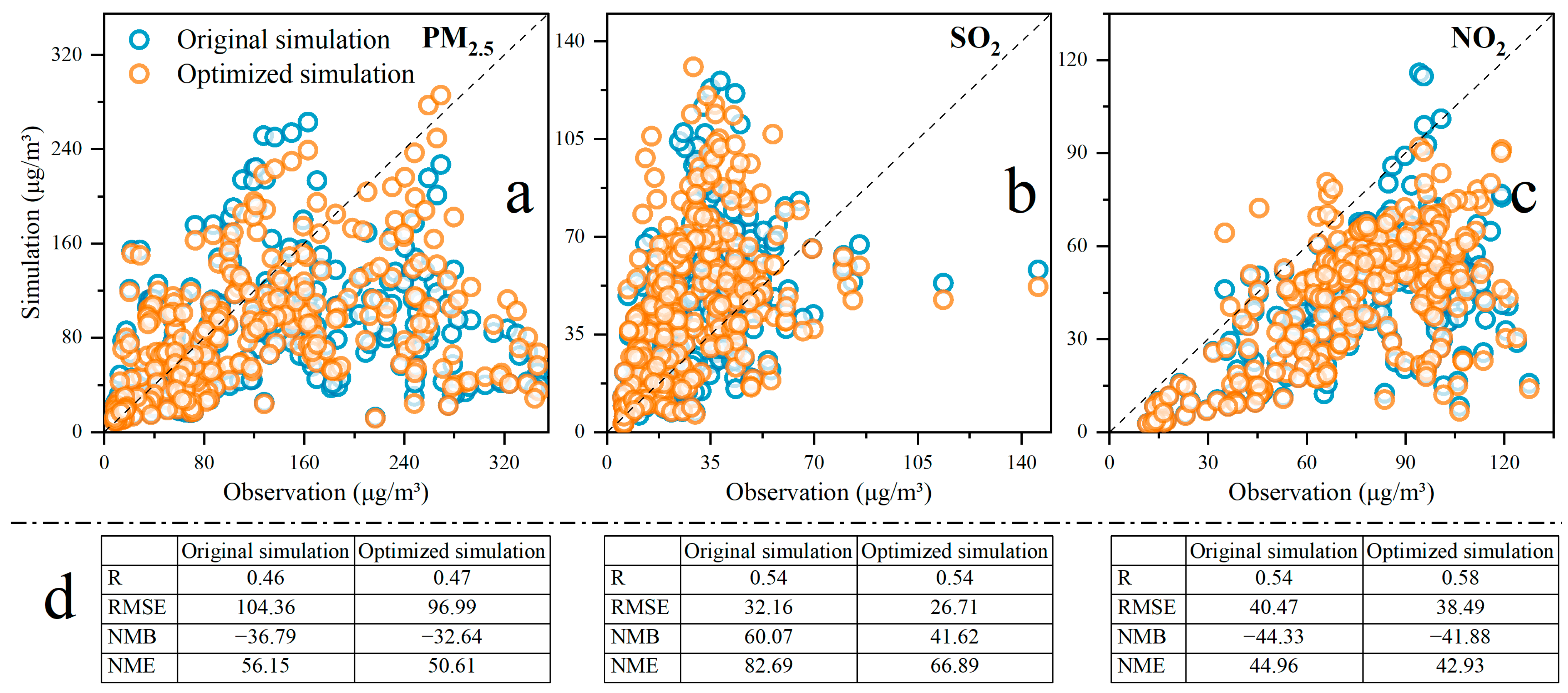
| Category | Cement Industries | Source | SO2 | NOx | PM2.5 |
|---|---|---|---|---|---|
| Emissions (t) | Clinker production enterprises | This study | 13,930.02 | 12,532.38 | 9160.61 |
| MEIC | 14,036.04 | 12,768.70 | 9223.31 | ||
| Separate cement grinding stations | This study | / | / | 5154.02 | |
| MEIC | / | / | 5208.98 | ||
| Category | Simulation Period | Measures | SO2 | NO2 | PM2.5 |
| Hourly Concentrations (μg/m3) | 9–14 January | R | 0.63 | 0.55 | 0.61 |
| RMSE (μg/m3) | 15.09 | 50.37 | 97.95 | ||
| NMB (%) | 51.62 | −48.80 | −47.55 | ||
| NME (%) | 54.68 | 48.80 | 51.44 | ||
| 19–24 November | R | 0.87 | 0.96 | 0.77 | |
| RMSE (μg/m3) | 18.20 | 20.27 | 32.82 | ||
| NMB (%) | 38.32 | −30.41 | 12.08 | ||
| NME (%) | 41.44 | 30.41 | 36.54 |
Disclaimer/Publisher’s Note: The statements, opinions and data contained in all publications are solely those of the individual author(s) and contributor(s) and not of MDPI and/or the editor(s). MDPI and/or the editor(s) disclaim responsibility for any injury to people or property resulting from any ideas, methods, instructions or products referred to in the content. |
© 2024 by the authors. Licensee MDPI, Basel, Switzerland. This article is an open access article distributed under the terms and conditions of the Creative Commons Attribution (CC BY) license (https://creativecommons.org/licenses/by/4.0/).
Share and Cite
Bai, X.; Li, P.; Zhou, W.; Wu, H.; Li, C.; Zhou, Z. Temporal Refinement of Major Primary Air Pollutant Emissions Based on Electric Power Big Data: A Case of the Cement Industry in Tangshan City. Atmosphere 2024, 15, 895. https://doi.org/10.3390/atmos15080895
Bai X, Li P, Zhou W, Wu H, Li C, Zhou Z. Temporal Refinement of Major Primary Air Pollutant Emissions Based on Electric Power Big Data: A Case of the Cement Industry in Tangshan City. Atmosphere. 2024; 15(8):895. https://doi.org/10.3390/atmos15080895
Chicago/Turabian StyleBai, Xiaoxuan, Peng Li, Weiqing Zhou, Huacheng Wu, Chao Li, and Zilong Zhou. 2024. "Temporal Refinement of Major Primary Air Pollutant Emissions Based on Electric Power Big Data: A Case of the Cement Industry in Tangshan City" Atmosphere 15, no. 8: 895. https://doi.org/10.3390/atmos15080895





